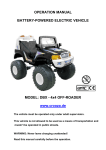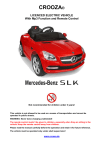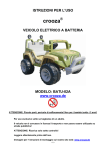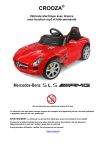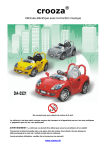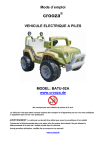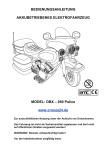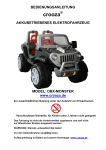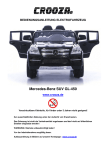Download Crooza MABU-01 Technical data
Transcript
OPERATION MANUAL ® crooza BATTERY-POWERED ELECTRIC VEHICLE MODEL: MABU-01 www.crooza.de The children must operate the vehicle under adult supervision. This vehicle is not allowed to be used as a means of transportation and cannot be operated in public streets. WARNING: Never leave charging unattended. Read this manual carefully before the operation. OVERVIEW Instructions 2 Components/Assembly Materials 3 General Overview 5 Charging Batteries 6 Assembly Instructions 7 Attaching Batteries 13 Maintenance and Disposal of the Batteries 14 Instructions For A Safe Operation 15 Operating Mode 16 Maintenance Instructions 17 Troubleshooting 18 -1- Technical Data Item no MABU-01 Age properly 3-7 Years old Vehicle Size 1070 x 720 x 670 mm Net weight 20 kg Load capacity 40 kg Environment temperature 0-40 °C Speed Ca. 3,5-7 km/h Battery 12V10AH Charger input Input: AC220V~240V/50Hz~60Hz Motor 2 x 30Watt Charging lifetime approx. 300 Charging time 18-22 Hours, never more than 30 hours once. SAFE OPERATION WARNING PREVENTING INJURIES • The vehicle must be operated only under adult supervision! • Never use the vehicle in darkness! • Operate the vehicle only in safe areas! E.g: In areas - without swimming pools or ponds. Risk of drowning! - without slopes! - far from stairs, ramps, streets and boulevards! • Operating Directives: Ensure that the following rules are followed for a safe operation: - Always sitting properly on the seat, getting on and off only when the vehicle is off. - No driving without shoes. - Only one (1) child must drive the vehicle. OPERATION IS AT USER’S RISK. PARENTS ARE RESPONSIBLE FOR THEIR CHILDREN. INSTRUCTION • Small items are included in the package at delivery status. Assembling must be conducted by adults. • The charger must be used only in a dry environment. -2- Components/Assembly Materials • Check if all the parts are available. Keep the package until you complete assembling and become sure that there are no parts missing. • Some parts are hidden under the seat. Lift the seat to get the batteries and other assembly parts. • The surfaces of the metal parts are covered with lubricant for protection. Before installing, clean the lubricant residues on metal parts by rubbing them with a cloth. Chassis Handle bar Seat 2 x Front tire Setting plate 2 x Pin for Rear Wheel 2 x Rear tire Frontal covering Bumper -3- Rear axle 4 x Hub cap 12 Volt Battery 4 x Wheel cap 4 x Centering sleeve 12 Volt Charger 2 x Handle Diverse Screws, Washers und Fixing pins Screws Washer -4- Fixing pin General Overview The parts shown here are also on the other side of the vehicle. 18 1. 2. 3. 4. 5. 6. Vehicle chassis Handle bar Seat 12 Volt Battery Rear axle Pin for rear wheel (x2) 7. 8. 9. 10. 11. 12. Tire (x4) Wheel cap (x4) Washer (x6) Fixing pin (x4) Hub caps (x4) 12 Volt Charger -5- 13. 14. 15. 16. 17. 18. Centering sleeve (x4) Handle (x2) Handle bar plate Setting plate handle rod Frontal covering Bumper Charging the Batteries ELECTRIC SHOCK WARNING • Unfixed batteries may fall off the overturned vehicle and cause injury. Ensure that the batteries have been fixed carefully. • FIRE PREVENTION - The electric system of the vehicle is not allowed to be altered. Alterations may lead to fire, black-out of the electric systems and serious injuries. - Using wrong batteries and chargers may lead to fire, explosion and serious injuries. - Only adults are allowed to handle batteries. The batteries, which are quite heavy, are filled with electrolyte. Leaking batteries may lead to serious injuries. - Do not let your children to charge the batteries. Only adults are allowed to charge the batteries. Only adults are allowed to charge the batteries and the charging process must be supervised continuously. Children may get injured by an electric shock. - Before charging the batteries, read the safety instructions about batteries. - Please check the batteries, cable connections and the connector of the charger before charging the batteries. If you find any defects, do not charge them until they are repaired by an expert. - The motors produce HEAT! Be careful during the contact with the motors. WARNING The charger must be used only in a dry environment. - The battery has a thermal fuse. The thermal fuse moves back on its own and disrupts the operation when there is an overload or an adverse condition. If the fuse blows out, take the foot from pedal and wait for approx. 25 seconds before the vehicle is operated again. In order to avoid repeated operational disruptions, ensure that the vehicle doesn’t carry more than 40 kg. Avoid unfavorable conditions such as slopes or solid objects like walls. Otherwise, the wheels may stand still and the motors may get overcharged. Teach your child to keep the vehicle still before changing the direction. - If the fuse doesn’t comply with the normal operational conditions, contact your service. - Before the first operation, the batteries must be charged 18-22 hours once. - While being charged, the batteries must stand vertical. - The charger is not a toy. - The batteries mustn’t be short-circuited. - The batteries mustn’t be taken out of the vehicle for charging. - Charging through contaminated socket can lead to short-circuit and other defects. Therefore, it must be refrained. - The charging process must be carried out safely, far from easily inflammable materials. Look out excessive smoke and heat generation. - The charging process must be conducted continuously under adult supervision. -6- ASSEMBLY INSTRUCTIONS WARNING In the loose delivery status of the vehicle, children may hurt themselves with sharp parts or electric components. Please be careful while opening the package, assembling the small parts and attaching or handling the batteries (especially when you are assembling the vehicle with your child). • Insert the connecter A into the charger jack. • Then connect the charger to the socket on the wall. • The vehicle must be turned off! Instructions: - Use the charger only on one wall socket. Because of its own weight, the charger mustn’t be connected to an overhead socket. - If the wall socket has a switch, ensure that it is on and there is power supply. - Charge the batteries 18-22 hours before the first operation. Do not charge them longer than 30 hours once. - When the batteries are completely empty, charge them at least 14 hours. Do not charge them longer than 30 hours once. - After charging, disconnect the connector from the vehicle and the charger from the socket. -7- 1. Connect a fixing pin to the end of the rear axle. 4. - 2. - Attach a washer to the rear axle. Put a hubcap. Put a tire marked ‘L’. Pull a pin through (with the ring end as shown). Connect all the parts. - Bring the other rear wheel pin on the rear axle. Ensure that the rear wheel pin is set on the motor correctly. Pull a pin with the ring end inwards as shown above. Put a tire marked ‘R’ with the flat side inwards as shown above. Then, attach a wheel cap with the vaulted side outwards as shown. Put a washer. 3. - Lay the vehicle down on its top side. Position the rear axle as shown. Ensure that the rear wheel pin is set on the motor correctly. -8- 5. - Finish assembling the rear axle by fixing everything with a fixing pin. 8. - Attach Stabilizer/Setting plate as shown. Put a screw through the opening and fix it. 6. - Put the rod of the handle bar in the opening on the front side of the vehicle. 9. 7. - - Lift the front part of the vehicle carefully. Ensure that the control rod is set completely and correctly. Press the wishbone until the control rod is set in the related place. - Attach a washer to the front axle. Pull a pin through (with a ring end firstly). Pull a tire marked ‘L’ with the flat side inwards as shown above. Finish the formation with a wheel cap. Attach all the parts to each other and put a washer. -9- 10. - Attach the fixing pin to the related place. Repeat the 10. and 11. steps on the other side of the front axle. 12. - Position the frontal covering. Note: The vehicles are delivered partially with preassembled frontal covering. 11. - Attach each hub cap to the wheels by pressing them until they are fixed completely. Put the vehicle on its wheels. 13. - - 10 - Position the bumper on the frontal covering. Put two screws into the lower openings and fix them. 14. 16. - - Put two screws in the upper openings and fix them. 15. - If they are not assembled before, put the handles to the ends of the handle bar. Note: If you have problems with putting the handles, dampen the inner sides of the handles with water. Locate the opening under the switch. Pull out the loose cable inside the opening and connect them with each other. - You can find more information about High-Speed function on Page 17. If you want to double the speed, check our High SpeedMotors Sets on http://www.crooza.de . 17. - Firstly, attach the front side of the seat as shown in Position A. - Then, attach the end of the seat as shown in Position B. INFO: For a more detailed manual, visit our Homepage www.crooza.de - 11 - Attaching Batteries IMPORTANT! Only 12V Batteries must be used. Other batteries can damage the motors of the vehicle. Before the first operation, the batteries must be charged at least 18 hours once through the provided charger. Before each operation, the batteries must be charged at least 14 hours. Do not charge the batteries longer than 30 hours once. Otherwise, the batteries can get damaged. 3. - Bring the battery holder to the locked position and fix the battery. 1. - Press the ledge on the back side of the vehicle and lift the seat. 4. 2. - Pull the battery holder up. - Place the battery vertically. - 12 - - Firstly, attach the front side of the seat as shown in Position A. - Then, attach the end of the seat as shown in Position B. Instructions For A Safe Operation DANGER ! WARNING PREVENTING INJURIES: • The vehicle must be operated only under adult supervision! • No driving in darkness! • Operation only on safe grounds! E.g: In areas - without swimming pools or ponds. Risk of drowning! - without slopes! - far from stairs, ramps, streets and boulevards! • Operating Directives: - For a safe operation, ensure that these rules are learnt and followed by the children. - Always sitting properly. No standing in the vehicle. - No driving without shoes. - Before getting on and off, the vehicle must be stopped completely. - Only one (1) child must operate the vehicle. Explain the instructions below to your child: Right after seeing the vehicle, your child will want to drive it immediately. Children are not capable of judging, realizing and assessing dangers. Unsupervised operations can lead to serious injuries. Before letting your child drive the vehicle, you must check the area and your child’s ability to judge and drive the vehicle safely. Even if children are instructed before, they are not capable of foreseeing the dangers and turning away from them. There are no other directly supervision options for adults. Set up safety rules adapted to local conditions alongside the instructions below about using the vehicle. Ensure that these instructions are followed. All of these rules must be obeyed by the children who will play with your child as well. Instructions for a safe operation: Ensure that children learn and obey the rules below: 1. Always sitting properly on the seat. 2. No driving without sturdy shoes. 3. Only one (1) child must get on the vehicle. If the child sits improperly or stands in the vehicle, he/she may fall off; the vehicle may overturn and this may lead to serious injuries. 4. Do not allow your child to drive the vehicle in the streets or roads where motored vehicles are driven. 5. Do not allow your child to drive the vehicle near swimming pools, ponds, barriers (e.g: furniture, trees with low branches etc.) or overhanging building parts (e.g: stairs, wall projections etc.). 6. No driving in darkness! • An unexpected barrier may cause an accident. • Driving only in daylight or well-lit areas. 7. Forbid your child to drive on uneven grounds. 8. Do not allow your child to drive down the stairs. • Even if the pedal isn’t stepped, it may reach a high and dangerous speed. • The vehicle may overturn. • The motor may stop suddenly and the vehicle may roll down the stairs together with the child. 9. Moving things must be kept away. Revolving things like motor, gearbox and wheels can jam the fingers, hair etc. and lead to serious injuries. Do not allow your child to operate the vehicle in lateral or over-head position. 10.Do not use any easily inflammable materials near the vehicle. The vehicle has electric switches (like all the switches) which spark when triggered. Easily inflammable liquids can catch fire. 11.Take the batteries off to prevent an unsupervised operation. - 13 - • Turning the right handle while driving forward activates the High-Speed Mode of the vehicle. Then, the vehicle will go forward with approx. 7,5 km/h. IMPORTANT! For the safety of your child and to avoid injuries led by the gearbox of the vehicle, teach your child not to change direction while driving. • Press the D-N-R Switch on the tank. • If the pedal is stepped when D is switched, the vehicle will move forward. • Practice with your child and show him/her by which speed the steering wheel must be turned when the vehicle is moving forward in HighSpeed Mode. ATTENTION! The vehicle must be operated ONLY outdoors. NOTE: If the right handle is turned during the operation, High-Speed Function will be activated. A big part of floor coverings, which have been misplaced, can be damaged by the vehicle. • If N is switched, the vehicle will not move. • If the pedal is stepped when R is switched, the vehicle will move backward. • Practice with your child and show him/her by which speed the steering wheel must be turned. • The vehicle has a break system, by means of which the vehicle stops automatically as soon as the pedal is disengaged. • Ensure that your child knows how to steer and to stop the vehicle. - 14 - The manufacturer is not responsible for the damages occurring on floor coverings. Maintenance Instructions Check if all the screws, nuts and caps are set correctly and firmly. Ensure that none of the plastic parts are damaged and broken. In snowy or rainy weather, keep the vehicle in a dry room which has a ceiling. Even if the vehicle won’t be used, charge the batteries at least once a month. The vehicle can be cleaned with a wet cloth. Avoid any contact of water with the electric system of the vehicle. Contact of water with motor and electric components can lead to corrosion and damage on the motor and the electric components/switches. Do not use the vehicle on the sand. Sand in the motor, gearbox or electric components causes blockades and blackouts of the related parts. The vehicle can be cleaned with a dry cloth. In order to restore the original gleam of the vehicle, you can work on the plastic parts of the vehicle with a wax free furniture polish. NEVER use a car polish. For a safe operation, it is recommended that the vehicle is checked regularly by an authorized service point. - 15 - Troubleshooting Problem The vehicle doesn’t function Possible Cause Solution The battery wasn’t charged. The batteries must be charged at least 18 hours once before the first operation. After every operation, batteries must be charged at least 14 hours once. Do not charge the batteries longer than 30 hours once. Check all the cable connections. Ensure that charger jack is connected both to the vehicle and the socket. Check if the wall socket is under power. The charger doesn’t work. The fuse blew out. The fuse burns out when the vehicle is overcharged or used under adverse conditions. If a fuse burns out, it must be replaced. In order to avoid repeated operational disruptions, ensure that the vehicle is not loaded with more than 40 kg or doesn’t drag anything with it. Avoid adverse conditions like slopes or solid objects. This can stop the wheels, motor power and lead to overturning. Loose cables and connections Check all the cable connections. Ensure that the connector of the motor is attached to the battery and all the cables are connected properly. Defected battery If the battery is old or the instructions about the batteries weren’t applied, it can be defected. Contact the Service Center. Defected switch The electric switch can be corroded due to the contact with water or mud or blocked with dust and sand. Defects on motor Sudden disruption during the operation Whether a charger functions correctly can be understood with the help of a voltmeter. If you are not sure about whether your charger functions correctly, contact your Service Center. Contact your Service Center for diagnosis and reparation. Loose cable connections Check all the cable connections. Ensure that the connector of the motor is attached to the battery and all the cables are connected properly. Burn-out of the fuse The fuse burns out when the vehicle is overcharged or used under adverse conditions. If a fuse burns out, it must be replaced. You can find the Proper Replacement on www.crooza.de - 16 - Problem Short operation time Possible Cause Solution The battery wasn’t charged. The batteries must be charged at least 18 hours once before the first operation. After every operation, batteries must be charged at least 14 hours once. Do not charge the batteries longer than 30 hours once. Check all the cable connections. Ensure that charger jack is connected both to the vehicle and the socket. Check if the wall socket is under power. Overcharged batteries. Do not charge the batteries longer than 30 hours once. If you think that batteries are damaged due to overcharging, contact your Service Center. The batteries are old and are not charged fully. Even when the batteries are used properly, they have a limited lifetime. Depending on the operation period and conditions, its lifetime can change between approx. 1-3 years. In such a case, replace the batteries with the same model. Do not try to change only some parts of the batteries. Burn-out of the fuse The fuse burns out when the vehicle is overcharged or used under adverse conditions. If a fuse burns out, it must be replaced. In order to avoid repeated operational disruptions, ensure that the vehicle is not loaded with more than 40 kg or doesn’t drag anything with it. Avoid adverse conditions like slopes or solid objects. This can stop the wheels, motor power and lead to overturning. You can find the Proper Replacement on www.crooza.de The vehicle is inactive The battery wasn’t charged. The batteries must be charged at least 18 hours once before the first operation. After every operation, batteries must be charged at least 14 hours once. Do not charge the batteries longer than 30 hours once. Check all the cable connections. Ensure that charger jack is connected both to the vehicle and the socket. Check if the wall socket is under power. The battery must be recharged. The batteries must be charged at least 14 hours once after every operation. The vehicle is overcharged Ensure that the vehicle is not loaded with more than 40 kg or doesn’t drag anything with it. Adverse operational conditions Avoid adverse conditions like slopes or solid objects. Operate the vehicle generally on flat and firm grounds. - 17 - Problem The vehicle functions with a reduced speed. Possible Cause High-Speed connector isn’t connected. IMPORTANT: In Backwards mode, High-Speed function is automatically off. When the pedal is stepped, only one wheel revolves. Solution At delivery status, The vehicle is on Low-Speed Mode. In order to turn the High-Speed Mode on, you must attach the High-Speed connector. For more information, visit Page 18. IMPORTANT: For safety reasons, the High-Speed function can be operated only on Forward-Mode. The vehicle is in LowSpeed Mode. On Low-Speed Mode, only one wheel may revolve when the vehicle is lifted up. Generally, this is not a problem. Check the correct function of the vehicle by lifting it up and stepping on the pedal. If only one wheel revolves, try to slow the revolving wheel with hand carefully. Then start turning another wheel. If it doesn’t revolve, it means that there is a problem. Contact your Service Center for diagnosis and reparation. Check if the screws on the electromotor of the gearbox are loose. The vehicle sometimes functions, sometimes doesn’t. Loose cable connections Check the cable connections and ensure that everything is firm. Defected motor or switch Contact your Service Center for diagnosis and reparation. Loose cable connections Check the cable connections and ensure that everything is firm. ‘Dead Point’ on the electromotor Contact your Service Center for diagnosis and reparation. Defected battery or charger Change the batteries and the charger. Replacement parts are on www.crooza.de There has been a direction change without stopping the vehicle. Teach your child to change direction after stopping the vehicle. Loud ticktack or rubbing sound from the gearbox Broken gear-wheel in the gearbox Change the defected gearbox. Replacement parts are on www.crooza.de The charger gets warm. This is normal; some chargers get warm during charging. Nothing must be done. When pedal is stepped, the vehicle doesn’t move without pushing. The fuse burnt out although the vehicle wasn’t overcharged and operated under adverse conditions. The battery produces blubber sound while being charged. This is normal; some chargers produce this kind of sounds during charging. If your charger doesn’t get warm during charging, it doesn’t mean that there is a problem. Nothing must be done. If your batteries produce no sounds during charging, it doesn’t mean that there is a problem. - 18 - Instructions Related to the Maintenance and Disposal of the Vehicle MAINTENANCE If a battery is leaky, remove the battery which has acid escaping by avoiding skin contact and put the battery in a plastic bag. Please check the description on the right side to learn how the battery can be disposed in the right way. In the event of skin or eye contact, rinse the affected part in running water for at least 15 minutes and see a doctor. When acid is swallowed, water, milk etc. must be drunk or egg white eaten immediately. Never try to throw up. Call the doctor instantly. Before the first operation, the batteries must be charged with the help of the provided charger for at least 18 hours once. Never charge the batteries longer than 30 hours once. Overloading and excessive discharge shorten the battery life and operating period substantially. Before every operation, the batteries must be charged approximately 14 hours. Charge the batteries after every operation, no matter how long the vehicle was operated. The batteries must stand vertical while being charged. Do not discharge the batteries completely before charging them again. Charge the batteries for a long time before putting the vehicle away. Even if the vehicle won’t be operated, charge the batteries at least once a month. Batteries left empty will definitely stop working later. Never leave leaking batteries in the vehicle. Leaking liquid can damage the vehicle. Do not keep the batteries on the surfaces like the countertops in kitchens; they may get damaged. Take precautions related to the protection of these surfaces before you put the batteries. Do not keep the batteries above 24°C and below -23 °C. Use only 12V Batteries. Do not forget to charge the batteries at least 18 hours before the first operation. Ensure that the batteries are not loose in the vehicle. Always use a battery fastener to lock the batteries. Check the batteries and the charger against imperfections and defects before every charging. If you detect a defect, do not charge the batteries until the defected part is repaired. DISPOSAL - 19 - The provided battery is overflow-protected and welded. It must be ecologically disposed and recycled. Do not throw the battery into fire. It may leak or explode. Do not dispose the batteries together with normal domestic waste. Disposing the batteries with normal domestic waste is prohibited by law! Protect the environment by not disposing the batteries with normal domestic waste (2202/96/EC). Get information about recycling and disposing options from the local administration in your vicinity. Pb Cd Hg Batteries separately disposed (not with domestic waste!) Don’t throw batteries into fire! Don’t open! The symbol „crossed-out waste container“ on the product and in the manual indicates that electric and electronic devices must be collected and disposed separately from normal domestic waste. There are various collection systems recovery and recycling available in the EU. about For more information, please consult your local authorities or your dealer. Please read the manual carefully and retain it for future reference. IMPORTANT! 1. All the illustrations serve the visualization and specification of the product. If you notice differences between the illustration and the product, follow the construction of the product. 2. Technical modifications in whole or in part to increase the product quality are expressively reserved without prior notice. dubax-marketing oHG WEEE-Reg.-Nr.: DE 33541416 Germany [email protected] Model: MABU-01 www.crooza.de All rights reserved Copying, Performing and Distributing - even in parts - only with written consent of Dubax-Marketing oHG Darmstadt. Copyright (©) by dubax marketing oHG Darmstadt / Germany.





















